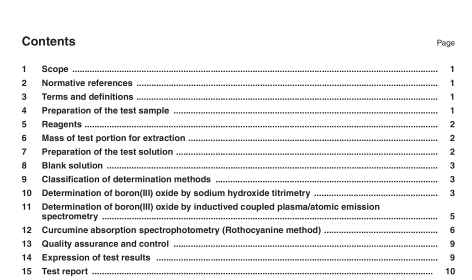BS EN ISO 21078-2:2007 – Determination of boron(III) oxide in refractory products — Part 2: Acid extraction method for the determination of boron(III) oxide in binder components

1 Scope
This part of ISO 21078 specifies procedures of chemical analysis for the determination of boron(III) oxide used as a binder component added to aluminosilicate refractories, using an acid extraction method.
It is applicable for refractories containing less than (mass fraction) of boron(III) oxide.
2 Normative references
The following referenced documents are indispensable for the application of this document. For dated references, only the edition cited applies. For undated references, the latest edition of the referenced document (including any amendments) applies.
ISO 31 -0, Quantities and units — Part 0: General principles
ISO 836, Terminology for refractories
ISO 3310-1, Test sieves — Technical requirements and testing — Part 1: Test sieves of metal wire cloth
ISO 3696, Water for analytical laboratory use — Specification and test methods
3 Terms and definitions
For the purposes of this document, the terms and definitions given in ISO 836 and the following apply.
3.1
dry unshaped refractories
dry particles and/or powder of unshaped refractories
4 Preparation of the test sample
4.1 Refractory brick or its raw material
Sampling is carried out in accordance with the contract between the user and producer. A specified quantity taken from a lot of the sample is crushed to pass through a sieve (see ISO 331 0-1) and reduced to about by riffling or quartering. Then all the reduced sample is ground to pass through a sieve (see ISO 3310-1).
4.2 Unshaped refractories
Prepare two approximately portions of the sample for analysis (both dry and wet), and crush to pass through a sieve (see ISO 3310-1), in accordance with the following procedure in 4.3 to 4.5.
4.3 Dry unshaped refractories
Take one bag or of the sample from a lot and reduce to about as above, and crush to pass through a sieve.
4.4 Laboratory sample
The laboratory sample from 4.1 or 4.2 is reduced to approximately by quartering, and ground to pass through a sieve. This is the test sample for analysis. It is transferred into a container [e.g. a flat weighing bottle ( ) or sample tube ( )], and dried in a desiccator with silica gel desiccant for a minimum of .
4.5 Weighing of test portion
The specified quantity of the test portion for chemical analysis shall be weighed to the nearest using an analytical balance and recorded.
Carry out the extraction process in duplicate.
5 Reagents
Use only reagents of known analytical purity and water conforming to the requirements of grade 2 of ISO 3696 (e.g. double-distilled water).
The boron and borate ion concentrations in the water and the reagents shall be negligible compared with the lowest concentration to be determined. All solutions are aqueous unless otherwise specified.
NOTE The reagents below are for the extraction process only. Reagents for the determination of B 2 O 3 are listed in the appropriate clauses.
BS EN ISO 21078-2:2007 – Determination of boron(III) oxide in refractory products — Part 2: Acid extraction method for the determination of boron(III) oxide in binder components